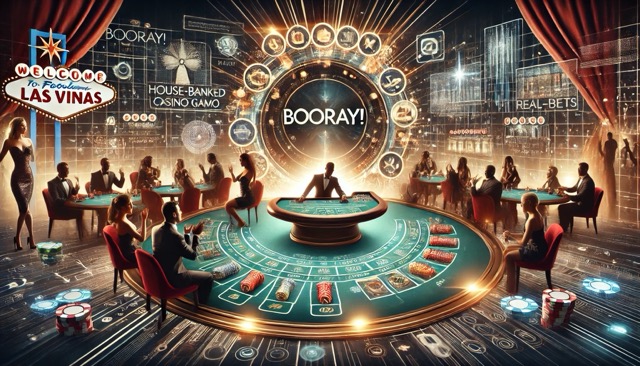
By Kahari S. Nash “The BooRay! King” & CEO KSN Gaming
Understanding House-Banked and Non-House-Banked Games
In the casino world, card games are typically categorized into two types: house-banked and non-house-banked. In house-banked games, such as blackjack and baccarat, the casino acts as the bank, covering all bets and ensuring a consistent house edge. This setup allows casinos to manage risk effectively while providing players with engaging experiences. Conversely, non-house-banked games, like traditional poker, involve players betting against each other, with the casino earning revenue through fees or rake rather than direct participation in the betting.
Transforming Peer-to-Peer Games into House-Banked Variants
Casinos have a history of adapting popular peer-to-peer card games into house-banked versions to introduce a controlled house edge. A notable example is Three Card Poker, which simplifies traditional poker into a fast-paced game where players compete against the dealer rather than each other. This adaptation incorporates a house advantage, making it profitable for casinos while retaining the essence of poker that players enjoy.
Another example is Ultimate Texas Hold’em, where players face off against the dealer with opportunities for strategic betting, all underpinned by a calculable house edge. These transformations require sophisticated mathematical modeling to balance the game’s appeal with the casino’s profitability.
House-banked games, where players compete against the casino, continue to dominate revenue streams. For instance, in October 2024, New Jersey’s online casinos reported $213.6 million in total revenue, with nearly 99%—approximately $211.3 million—stemming from house-banked games such as slots and table games. In contrast, peer-to-peer games like online poker contributed around $2.35 million, highlighting the significant revenue disparity between these game types.
The Role of Side Bets in Enhancing Player Experience
Side bets are additional wagers that players can place alongside the main game, offering the chance for higher payouts based on specific card combinations or outcomes. In blackjack, for instance, side bets like “Lucky Ladies” allow players to bet on receiving a pair of queens, with payouts reaching up to 100 to 1. However, it’s important to note that side bets often come with a higher house edge; for example, the “Lucky Ladies” side bet can have a house edge exceeding 24%.
While side bets can enhance excitement and provide opportunities for significant wins, players should be aware of the increased house advantage associated with these wagers.
Adapting BooRay! for the Casino Environment
BooRay!, a trick-taking card game with deep cultural roots and popularity among celebrities, presents a unique opportunity for adaptation into a house-banked casino game. The challenge lies in preserving the game’s core elements—such as its strategic depth and social interaction—while introducing a house-banked structure that ensures profitability for casinos.
This transformation involves several key steps:
• Strategic Design: Modifying game rules to allow players to compete against the house rather than each other, thereby establishing a consistent house edge.
• Mathematical Modeling: Employing advanced mathematics to calculate probabilities and set payout structures that are appealing to players yet advantageous to the casino.
• Creative Development: Designing engaging side bets and bonus features that enhance the gaming experience without compromising the game’s integrity.
Leveraging Celebrity Influence
The popularity of BooRay! among celebrities, particularly in the sports and entertainment sectors, provides a significant advantage in its commercialization. High-profile individuals with substantial social media followings can generate interest and attract new players to the game. Their endorsement serves as a powerful marketing tool, creating a sense of exclusivity and trendiness around BooRay!.
Pathway from Social Casino to Real-Money Gaming
Introducing BooRay! into the digital space via social casino platforms offers a strategic pathway to full-scale casino integration. This approach allows developers to:
• User Feedback: Gather insights into player preferences and behaviors, facilitating data-driven adjustments to game design.
• A/B Testing: Experiment with different rule variations and features to determine the most engaging and profitable configurations.
• Licensing Preparation: Refine the game to meet regulatory standards and player expectations in both online and brick-and-mortar casino environments.
By starting in the social casino arena, BooRay! can build a dedicated player base, fine-tune its gameplay mechanics, and seamlessly transition into real-money gaming platforms, ensuring a successful and sustainable launch.
In conclusion, adapting BooRay! from a traditional peer-to-peer card game into a house-banked casino offering involves a multifaceted approach that blends strategic design, mathematical precision, and creative development. Leveraging celebrity influence and utilizing social casino platforms as a testing ground further enhance its potential for success. By 2030, the global gambling market is projected to grow from $773.7 billion (2023) to $1 trillion (3.7% CAGR) due to new table games expanding the customer base at casinos. With careful planning and execution, BooRay! is poised to become a standout addition to both online and brick-and-mortar casino landscapes.








